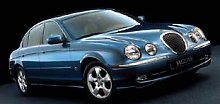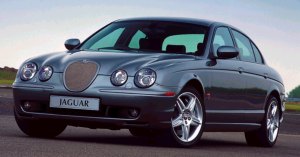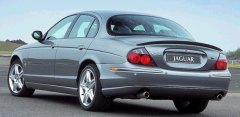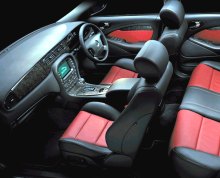 For
28 years, Jaguar's business relied on only one large sedan model plus a
coupe. From now on the situation will not be the same. The new S-Type
is
added to the range to target BMW 5 Series and Mercedes E class in this
highly profitable sector. And later a Ford Mondeo-based baby Jag will
complete
the trilogy so to make Jaguar a complete marque against the German. For
28 years, Jaguar's business relied on only one large sedan model plus a
coupe. From now on the situation will not be the same. The new S-Type
is
added to the range to target BMW 5 Series and Mercedes E class in this
highly profitable sector. And later a Ford Mondeo-based baby Jag will
complete
the trilogy so to make Jaguar a complete marque against the German.
The introduction of the S-Type must cause some embarrassment to the existing XJ8. Theoretically the XJ8 competes with the more luxurious Mercedes S-class / BMW 7 Series, but actually the S-Type has some 40mm longer wheelbase than the standard XJ8 and powered by nearly the same 4 litres V8. Of course it undercut a lot the XJ8 in price. So inevitably the sales of the bigger car will be influenced. Its styling gives me mixed impression : on the positive side, the nose section reminds me the golden days of Jaguar. The grille mirrors the 40's XK-120 and 50's Mk II sedan, both of which are the greatest classic cars in today. Twin circular headlights at each side is also the tradition of Jaguar, started by Mk II, then the original S-Type and then the long-serving XJ6. The bonnet is shaped to follow the curve of the grille and the headlights, making the car looks retro. Overall speaking, viewing from the front the S-Type is exactly a modern Mk II. If you have a good memory, you may remember the Mk II gave Jaguar a reputation as the expert of sports sedan, in then BMW was still producing boring cars. Can the new S-Type repeat its success ? However, looking from other angles, you may have very different feeling. At the rear, it looks like a Mondeo. Side view is no less disappointing. The curvy-looking window frames cannot hide the boxy shape of the body, simply because all hard points were already defined by Lincoln LS's chassis, on which the Jaguar base. It seems that the most beautiful part is still the front end. The cabin could be even more disappointing : there is no British ambience, no Jaguar's tradition at all. What you see is very similar to any low price American luxury cars, such as Lincoln or Cadillac. Not only the huge piece of wood looks tasteless, the dials look boring, the steering wheel looks ordinary, the hemi-circular centre console looks odd, but the fit and finish is also in question. Most plastics are of very poor grade that you can find in any mass production Ford. The glove box door doesn't fit very well, neither does every assembly gap. Nevertheless, its Lincoln root donate some modern elements. For example, the roof is much higher than XJ8, thus offer generous head room for the front occupants. Although the rear head room is tighter (due to the swoopy roof line at the rear), it is still roomier than its dearer sister. Leg room for both rows is benefited by the longer wheelbase. Higher driving position provides better visibility. For the first time, the Jaguar has a split rear seats which give access to the better-shaped boot. As already mentioned, the new Jag was developed in collaboration with the Lincoln LS sedan, of course under the instruction of parent company Ford. In its press release, Jaguar did not try to hide this, but it also spent a lot of words to persuade you to believe its engineers heavily involved the chassis, engines, suspension etc. from the design stage and brought Jaguar's character into its heart and bones. The 3-litre V6 engine is an example. Based on Ford Taurus's Duratec unit, it received a new cylinder head, lightweight camshafts, continuously variable valve timing at the inlet side, 3-stage variable induction pipe and drive-by-wire throttle. This makes an extremely remarkable output - 240hp and 221 lbft. In my memory, only Porsche 968 and Honda NSX have 3-litre engines to match these figures. Unlike the V6, the 4-litre V8 is based on the UK-designed AJ-V8. The V6's continuous VVT system replaces the original discrete design, so you and I must expect more power and torque. In fact, its output dropped from 290hp / 290lbft to the still respectable 281hp / 287lbft without any official explanation. Anyway, pushing the lighter body, Coventry claimed the manual version of V6 could sprint to 60mph from standstill in an unbelievable 6.8 seconds. Top speed is 146mph. The V8, which is available only in the form of 5-speed automatic, is claimed to be capable of reaching 150mph and complete 0-60mph in 6.6 sec. In reality, it is another story. Mated with manual transmission, Autocar timed the V6 took 8.3sec for 0-60, that is, one and a half seconds longer than claimed. Very slow indeed. Top speed barely reached 139mph, down 7mph. How to explain these figures ? the sub-standard 0.32 drag coefficient is one reason, the peaky engine is another, the tall gearing is the third and lastly, the 1645kg weight. Torque spread is biased towards high speed, one of the sign is peak torque appear at 4,500rpm. Real punch won't be available until 3,500rpm. This makes its power not easily accessible. What's wrong with the VVT ? Apart from slow response, the Taurus-based V6 does not rev as silky smooth as BMW or Lexus's straight six, does not sing as beautiful as Alfa V6 too. It couldn't be said as a world class engine. However, Jaguar expected it will take 88% of S-Type's sales in UK. The V8 is much more promising, perhaps because of its British root. It delivers power as strong and as creamy as the AJ-V8. Mated to it is a compulsory 5-speed auto, with Jaguar's traditional J-gate. Gear shift slicker than the optional 5-speed auto using in the V6. Because it weighs as much as 1732kg, again the performance has been recorded to be lower than claimed : 143mph, 0-60 took 7.2 sec. BMW 540i, Lexus GS400 and even Volvo S80 T6 could leave it in smoke. Handling and ride also deliver mixed impression. On one hand the double wishbones suspensions provide the remarkable suppleness we expect to a Jaguar, only slightly lag behind the 5-series which rides on aluminium suspension arms. Body control is also fine, no matter equipped with CATS or not. (CATS is an adaptive damping system, stands for "Computer Active Technology Suspensions") On the other hand, the throttle pedal is too light, so is the speed-sensitive variable assisted steering of the V6 version. (V8 is OK, probably due to the heavier nose) Obviously the Jaguar does not succeed in catching the class-leading BMW 5-series, which is the benchmark vehicle during the development of the S-Type. The brakes initially feels strong, but easy to fade. (the less professional AutoExpress did not notice this point) Overall speaking, S-Type has dynamic eclipsing the S80 T6 and Audi A6, but not yet reaching the level of Lexus GS and Alfa 166, let alone the mighty 5 Series. In terms of refinement, the quietness from engine is spoiled by wind noise coming from the A-pillar. Otherwise, it approaches very high standard, especially is the way the suspension soak up bumps. What a pity the build quality of the cabin let us down. As a whole, Jaguar has made a quite balanced car, at least for the V8 - decent performance, competitive handling, superb ride, good comfort and a distinctive design. If not sharing platform with Lincoln LS, it could be better in all these fields. Although I'd prefer a more characterful car like Volvo S80 or Alfa 166, most Mr. Average Businessman are likely to be in favour of the Jaguar, considering its overall balanced and famous brand name. The only risk is the Lincoln-like build quality. The sales target
is rather
conservative, Jaguar hopes to sell 55,000 S-Type annually, compared
with
the 200,000 units achieved by BMW and Mercedes. After all, this is
enough
to double the company's capacity from the current 47,000 per year.
|
| The above report was last updated on 18 Feb 99. All Rights Reserved. |
 BMW
M5 has been dominating the big sport sedan segment for 4 years.
However,
the following months will be decisive for determining the next King of
the segment for the next few years. Jaguar has just launched the 400hp
S-Type R, Audi will put its 450hp RS6 into production soon, while
Mercedes
E55 AMG is ready to raise the game to 470hp. All cars employ V8 engines
and drive through either rear or all wheels. Both Jaguar and Mercedes
get
their superpower by employing supercharger, while Audi uses twin-turbo.
However, they must first beat the Bi-Vanos-equipped, naturally
aspirated
BMW before claiming the title. Now Jaguar is the first challenger.
BMW
M5 has been dominating the big sport sedan segment for 4 years.
However,
the following months will be decisive for determining the next King of
the segment for the next few years. Jaguar has just launched the 400hp
S-Type R, Audi will put its 450hp RS6 into production soon, while
Mercedes
E55 AMG is ready to raise the game to 470hp. All cars employ V8 engines
and drive through either rear or all wheels. Both Jaguar and Mercedes
get
their superpower by employing supercharger, while Audi uses twin-turbo.
However, they must first beat the Bi-Vanos-equipped, naturally
aspirated
BMW before claiming the title. Now Jaguar is the first challenger.
 Undoubtedly,
the S-Type R is very quick, especially mid-range surge. However, it is
not M5-quick, blame to mainly the use of automatic and also a little
more
weight. It also loses to the current champion in terms of eagerness.
Don’t
get me wrong, the Jaguar V8 is by all means a superb engine in the
supercharging
world, but comparing to the best naturally-aspirated V8 - especially an
engine as famous as the M5’s - it lacks an instantaneous throttle
response.
This will, perhaps, never be changed as long as it is supercharged.
Undoubtedly,
the S-Type R is very quick, especially mid-range surge. However, it is
not M5-quick, blame to mainly the use of automatic and also a little
more
weight. It also loses to the current champion in terms of eagerness.
Don’t
get me wrong, the Jaguar V8 is by all means a superb engine in the
supercharging
world, but comparing to the best naturally-aspirated V8 - especially an
engine as famous as the M5’s - it lacks an instantaneous throttle
response.
This will, perhaps, never be changed as long as it is supercharged.
 The
rest of the package favours the Munich rival. Although S-Type R has
added
mesh grille, black window frames and tiny tail spoiler etc. to boost
visual
appeal, its round shape looks less purposeful than M5. Its new R-logo
is
also unknown to car lovers, unlike the famous M-logo. Inside, the
cockpit
is much the same as regular S-Type, hence too civilized to me. The M5’s
instrument cluster and driver-oriented console are much more
attractive,
also trimmed with better leather and employed high quality plastics.
Jaguar’s
steering wheel is another dull-looker - a big fault considering it is
what
the driver faces and touches all day. The same goes for seats, whose
leather
is not really first class. However, the biggest deficit is at the back
- S-Type’s rear seat has too little legroom and headroom to be called
an
executive car. It even fails to match the space of a Mercedes C-class.
The
rest of the package favours the Munich rival. Although S-Type R has
added
mesh grille, black window frames and tiny tail spoiler etc. to boost
visual
appeal, its round shape looks less purposeful than M5. Its new R-logo
is
also unknown to car lovers, unlike the famous M-logo. Inside, the
cockpit
is much the same as regular S-Type, hence too civilized to me. The M5’s
instrument cluster and driver-oriented console are much more
attractive,
also trimmed with better leather and employed high quality plastics.
Jaguar’s
steering wheel is another dull-looker - a big fault considering it is
what
the driver faces and touches all day. The same goes for seats, whose
leather
is not really first class. However, the biggest deficit is at the back
- S-Type’s rear seat has too little legroom and headroom to be called
an
executive car. It even fails to match the space of a Mercedes C-class.